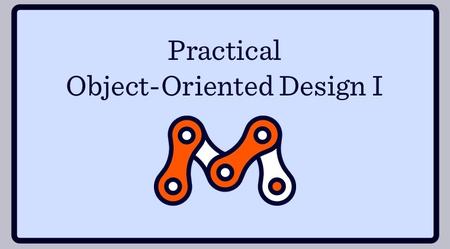English | MP4 | AVC 1920×1080 | AAC 44KHz 2ch | 66 Lessons (11h 49m) | 2.99 GB
Practical Object-Oriented Design I (POOD-I) is a course suitable for both beginners and experienced developers working with object-oriented programming.
The format is designed for individualized learning at a convenient time and pace. The course includes video lessons and hands-on exercises that teach you how to think in terms of objects through writing code. Each exercise requires incremental improvement of the solution in response to changing requirements, which helps develop flexibility and adaptability in design.
In the course, students learn the key principles of object-oriented design (OOP) to reduce the cost of new software development and simplify support for existing systems. If you want to write code that is enjoyable to work with and easy to maintain – or if you’re tired of unmanageable, messy applications – this course is for you.
The course also teaches techniques for refactoring and integrating testing into the development process. This helps speed up your current work and reduce bugs in future code.
Table of Contents
B. Watch: Writing the Tests
A. Watch: Listening to Change
B. Watch: Starting With the Open/Closed Principle
C. Watch: Recognizing Code Smells
D. Watch: Identifying the Best Point of Attack
E. Watch: Refactoring Systematically
Watch: Get a Whiff of This
A. Watch: Following the Flocking Rules
B. Watch: Converging on Abstractions
B. Watch: Replacing Difference With Sameness
C. Watch: Equivocating About Names
D. Watch: Deriving Names From Responsibilities
E. Watch: Choosing Meaningful Defaults
F. Watch: Seeking Stable Landing Points
G. Watch: Obeying the Liskov Substitution Principle
H. Watch: Taking Bigger Steps
I. Watch: Discovering Deeper Abstractions
J. Watch: Depending on Abstractions
A. Watch: Selecting the Target Code Smell
B. Watch: Extracting Classes
A. Watch: Appreciating Immutability
B. Watch: Assuming Fast Enough
A. Watch: Creating BottleNumbers
B. Watch: Recognizing Liskov Violations
Watch: All the Little Things
A. Watch: Consolidating Data Clumps
A. Watch: Making Sense of Conditionals
B. Watch: Replacing Conditionals with Polymorphism
A. Watch: Transitioning Between Types
B. Watch: Making the Easy Change
C. Watch: Defending the Domain
A. Watch: Contrasting the Concrete Factory with Shameless Green
B. Watch: Fathoming Factories
C. Watch: Opening the Factory
D. Watch: Supporting Arbitrary Class Names
E. Watch: Dispersing the Choosing Logic
F. Watch: Self-registering Candidates
G. Watch: Auto-registering Candidates
A. Watch: Converting Numbers to BottleNumbers
Watch: Go Ahead, Make A Mess
A. Watch: Appreciating the Mechanical Process
B. Watch: Clarifying Responsibilities with Pseudocode
C. Watch: Extracting the Verse
D. Watch: Coding by Wishful Thinking
E. Watch: Inverting Dependencies
A. Watch: Obeying the Law of Demeter
B. Watch: Identifying What the Verse Method Wants
C. Watch: Pushing Object Creation to the Edge
A. Watch: Choosing Which Units to Test
B. Watch: Reorganizing Tests
C. Watch: Seeking Context Independence
D. Watch: Communicating With the Future
A. Watch: Finding Shameless Green (up to 1:00)
C. Watch: Finding Shameless Green (1:00 to end)
A. Watch: Handling a New Requirement (up to 2:54)
C. Watch: Handling a New Requirement (2:54 to end)
A. Watch: Using Inheritance
A. Watch: Understanding Composition (up to 9:45)
C. Watch: Understanding Composition (9:45 to 12:17)
E. Watch: Understanding Composition (12:17 to end)
A. Watch: Seeking Abstractions (up to 1:05)
C. Watch: Seeking Abstractions (1:05 to the end)
A. Watch: Loosening Coupling
A. Watch: One Final Requirement (up to 1:05)
C. Watch: One Final Requirement (1:05 to end)
Watch: Nothing is Something
Resolve the captcha to access the links!
